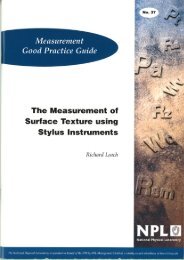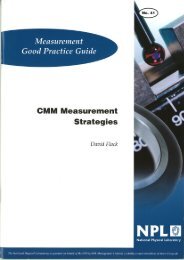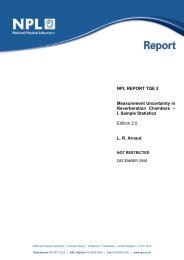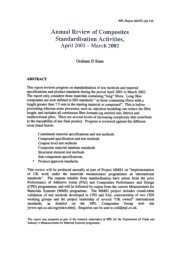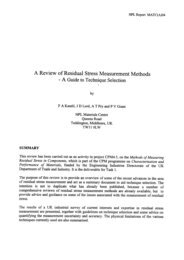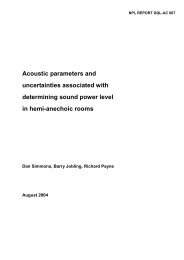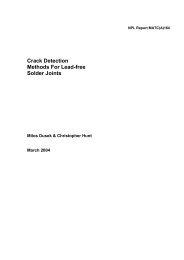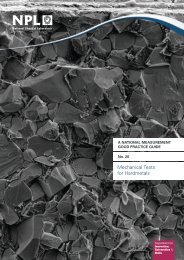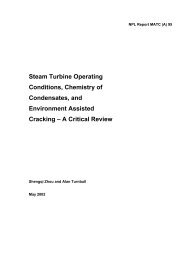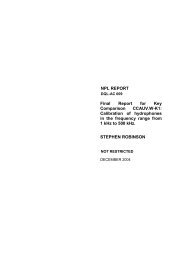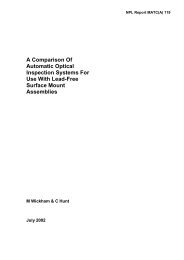Protocol for Establishing and Maintaining the Calibration - NPL ...
Protocol for Establishing and Maintaining the Calibration - NPL ...
Protocol for Establishing and Maintaining the Calibration - NPL ...
Create successful ePaper yourself
Turn your PDF publications into a flip-book with our unique Google optimized e-Paper software.
26 Good Practice Guide 93 Chapter 2<br />
Figure 2.5<br />
Variation in response <strong>for</strong> radial <strong>and</strong> axial displacements of 3 ml solution in 5 ml<br />
ampoule <strong>for</strong> <strong>NPL</strong> secondary st<strong>and</strong>ard radionuclide calibrator [23]<br />
Change in response (%)<br />
2<br />
1<br />
0<br />
0 0.5 1<br />
Radial displacement from central<br />
measurement position (cm)<br />
Change in response (%)<br />
0<br />
-0.05<br />
-0.1<br />
0 0.5 1<br />
Axial displacement from central<br />
measurement position (cm)<br />
The combined uncertainty arising from <strong>the</strong>se effects can be estimated simply by making a series of<br />
measurements, say 20, on a long-lived source. Firstly <strong>the</strong> source should not be removed from <strong>the</strong><br />
chamber between each measurement <strong>and</strong> <strong>the</strong> st<strong>and</strong>ard deviation, S 1 of this set of measurements<br />
should be determined. A similar series of measurements should <strong>the</strong>n be taken this time removing<br />
<strong>the</strong> source <strong>and</strong> replacing between each measurement. Again, <strong>the</strong> st<strong>and</strong>ard deviation, S 2 , should be<br />
determined. The square root of <strong>the</strong> difference between <strong>the</strong> squares of <strong>the</strong> two st<strong>and</strong>ard deviations<br />
should provide an estimate of <strong>the</strong> uncertainty that should be included in any measurement <strong>for</strong> <strong>the</strong><br />
effect of sample position, i.e. S position = (S 2 2 - S 1 2 ) ½ . If S 2 is close to S 1 , <strong>the</strong>n <strong>the</strong> positioning<br />
uncertainty may be regarded as negligible; a st<strong>and</strong>ard deviation value of less than 0.1% of <strong>the</strong><br />
measurement value is typical.<br />
2.7.5 Density<br />
<strong>Calibration</strong> factors are normally determined <strong>for</strong> aqueous solutions with a density very close to 1<br />
g/cm 3 <strong>and</strong> <strong>the</strong>re is very little work that has been reported which deals with <strong>the</strong> effect of densities<br />
that vary greatly from this. It is not possible now to give any definitive advice on this effect. For<br />
typical measurements made in Nuclear Medicine departments <strong>the</strong> sample density should not be<br />
much different from one.<br />
2.7.6 Homogeneity<br />
Given that <strong>the</strong> vast majority of sources are liquids, homogeneity should not be a problem provided<br />
<strong>the</strong> source is well mixed. For situations where <strong>the</strong>re is a potential <strong>for</strong> activity to settle, <strong>for</strong> example<br />
in <strong>the</strong> case of colloids or macroaggregated albumin <strong>for</strong> lung perfusion imaging, it is a relatively<br />
simple task to ensure <strong>the</strong> source is well mixed <strong>and</strong> <strong>the</strong>n monitor <strong>the</strong> chamber response over a period<br />
of time which is greater than <strong>the</strong> normal time between source preparation <strong>and</strong> measurement. This<br />
should provide an indication of <strong>the</strong> magnitude of <strong>the</strong> effect that might be expected in normal<br />
situations. It is more sensible in routine practice, however, to ensure that <strong>the</strong> liquid is well mixed<br />
be<strong>for</strong>e measurement.<br />
2.7.7 Adsorption<br />
The possibility exists that active material may be adsorbed (plate-out) onto <strong>the</strong> surface of <strong>the</strong><br />
sample container. This is most likely when <strong>the</strong> solution is essentially carrier-free. Such effects<br />
have been observed in <strong>the</strong> past with 201 Tl (up to 30% of <strong>the</strong> activity being absorbed onto <strong>the</strong> glass<br />
surface), 67 Ga (up to 10%) <strong>and</strong> 111 In in P6 vials. The replacement of P6 vials with 10R Schott,<br />
Type+1 vials has virtually eliminated this effect. However, caution should be used particularly<br />
when new <strong>for</strong>mulations are used. It is advisable to re-measure vials after <strong>the</strong> active solution has<br />
been withdrawn <strong>and</strong> to conduct an activity balance calculation. Any residual activity observed in



